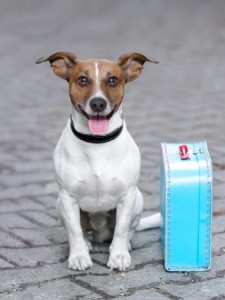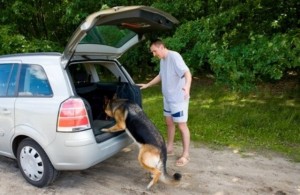With summer right around the corner, you may be thinking about taking a vacation with your family and of course you want to bring your four-legged family member, too! According to AAA, more than half of U.S. pet owners take their dogs with them when they go out of town. It’s a lot more fun if you can spend your vacation with your best friend plus you don’t have to worry about him while you’re away. Traveling with your dog can be easy and enjoyable for both you and your dog – all it takes is some preparation and practicing safety precautions while on the road. By planning ahead, you can make your vacation a truly relaxing experience, so below are some tips to help you prepare for traveling with your dog.
Pet-Friendly Hotels
As you begin planning your trip, one of the first things you need to do is research and locate pet friendly accommodations where you can stay with your dog. The last thing you want is to pull up to your hotel and find out that dogs are not welcome! Quite a few hotels accept dogs as guests but the policies can vary from one hotel to another. Many hotels have weight limits for dogs, so if you have a large German Shepherd, you might need to find a hotel that does not have weight restrictions. Most pet friendly hotels charge a pet deposit fee that is non-refundable, and additionally charge a daily service fee. Some pet friendly hotels cater to their canine guests by offering special doggie beds (turn down service with a cookie is optional), dog spa services and even doggie day care. So while you are doing your research, check into what amenities are available for your dog and remember to ask what extra costs are involved for these services. When you first arrive at the hotel, take your dog around his new “home” and set up a special area in your hotel room that is designated just for your dog with his food, water, bedding and his favorite stuffed animal or toys. If your dog seems concerned about the noises outside your hotel room, you can leave on a fan or turn on some white noise to help mask the sounds. Remember – the more comfortable the setting is for your dog, the more relaxed he will become. And after a long day of traveling with your dog, it would be nice to unwind in your hotel room with a calm, happy dog. If you’ve been on the road for a while it might be good to take your dog outside and go for a jog together, or play a game of fetch so he can get a little exercise before you settle in for the night. You’ll find that pet friendly hotels commonly have designated areas just for dogs, so anytime you take him outside make sure you are being courteous to others by keeping him on a leash and always clean up after him. It’s also common for pet friendly hotels to ask that you do not leave your dog alone in the hotel room for several reasons; he may begin barking or possibly become destructive from the stress of being alone in an unfamiliar setting. Here are a few websites that you can use to help locate pet-friendly hotels where you can stay while you are traveling with your dog: GoPetFriendly.com, BringFido.com, Hotels.com, and Marriot.com.
Vet Check Up
With all the hard work and preparation that you’re doing to make sure your vacation is relaxing, the last thing you want is for your dog to become sick while you’re away from home. So before you leave on your trip, a quick visit to the vet for a medical checkup is a great idea just to ensure that your dog is healthy. This is a good time to see that he’s up to date with all his necessary vaccinations and has enough of any needed medications for the trip. Cross-state travel and some hotels require a health certificate and proof of rabies vaccination, which your vet can provide to you during your dog’s visit. If you haven’t already, get your dog microchipped just in case you and your dog become separated during your trip. Take along your dog’s medical records and your vet contact information in case your dog needs medical care while you’re traveling. Also, before you leave on your trip, locate emergency animal clinics along your route and close to where you’re staying in the event that an emergency does arise. The American Animal Hospital Association is a good resource to help you find facility locations.
Getting Used To Traveling
Before you head out on your trip, you’ll need to get your dog used to traveling in your car. Begin slowly, first by letting your dog sit with you in your car with the engine turned off, praising him and giving him treats throughout the training session. Try this for a few days, then turn on your car engine but still don’t take him anywhere. As he becomes more comfortable sitting in your car, you can start taking him for short rides – first to the end of your driveway and back or around the block. As you continue to make progress, try going somewhere fun like to a nearby dog park or a local hiking trail so he’ll start to associate car rides with positive experiences. Take him to a local doggie bakery or a dog supply store and let him pick out a new toy – with these experiences he’ll get over his fear of car rides quickly! If you plan on traveling with your dog with a travel kennel or a harness, you’ll need to spend some time with him so he can get used to this as well. If you decide to travel using a dog kennel, try setting it up inside your house first so your dog can get familiar with it and see it as a safe place just for him. Once he’s become a pro at taking day trips, you might want to try an overnight trip to a friend’s or relative’s house, so your dog can sleep in a new place and get used to new people and unfamiliar sounds. Traveling with your dog can be a lot of fun, but if you find that your dog is not adjusting to the car or to day trips, then taking a road trip is probably not the right option for you and your dog.
What To Bring
As you’re trying to decide what you need to bring on your trip, don’t forget to pack a travel bag for your dog, too! Just like people, dogs like the comforts of home so you’ll want to bring his bedding, toys, treats, brushes and even his dishes (a waterproof zippered tote bag would be perfect for packing his supplies). Most important, make sure you bring your dog’s own food from home – you do not want to try to stop on the way to pick up his food or see if it’s available at your final destination. Your dog’s brand of food might not be easy to find, and you don’t want to change your dog’s diet when you’re traveling as it could upset his stomach. Equally important, drinking water from unfamiliar areas could also upset your dog’s stomach. So you’re going to need to bring bottled water or tap water from home that is stored in clean, plastic jugs. You’ll also need to check that your dog’s tags are up to date with your home address and cellphone number, and you might want to get a second (temporary) pet ID tag as well that has the address and phone number of where you’re staying during your trip. As an additional precaution, bring along a recent photo of your dog, too, just in case you somehow get separated during the trip. Other essentials to bring include a travel crate or harness, water and food bowls, collar, leash, bedding, toys, treats, medications, grooming supplies, waste disposal bags and a first aid kit. If you give your dog supplements, such as InflamAway HA joint supplements, you’ll want to bring them along as well. Here’s a list that you can print and use to help plan what you’ll need to take with you.
Safety First
If the decision was left up to your dog, he’s probably choose to travel free-range in your car, jumping from the back seat to the front seat and hang his head out the window with his ears flapping in the wind. However, it’s never a good idea to keep your dog loose in your car, as he can easily get injured or distract you while you’re driving – according to the AAA about 30,000 accidents are caused each year by an unrestrained dog in the front seat. You’ll need to do a little research and learn about the different types of restraints that are available and decide which one is best suited for your dog. There are a wide variety of pet restraint options to choose from, including dog travel crates, pet harnesses, vehicle barriers, pet car seats and pet seat belts. Plan on traveling with your dog in the back of your car; it might be tempting to keep him on the passenger seat next to you for company, but if you need to brake suddenly or an airbag deploys while your dog is in front, it could easily injure him. Once you’ve decided on what type of safety restraint you want for your dog, take time before your trip to get your dog familiar with it so he’s comfortable while you’re traveling. Here are a few choices:
Travel Kennel: If you decide to travel with your dog in a travel kennel (crate), it needs to be well secured inside your car with straps or a harness so that it does not move around while you are driving. Your dog should have plenty of room to completely stand up, sit down and turn around/lay down without a problem. It should also be well ventilated (some carriers are even temperature-controlled) and cushioned for comfort with a soft foam dog bed that fits directly into the bottom of the kennel.
Safety Harness: Another option is a dog safety harness which gives your dog some freedom of movement while also providing security in case of a sudden stop. Safety harnesses come with a soft breathable padded vest that your dog wears and can be adjusted to fit your dog, and is then attached to the car seat belt. Some harnesses also come with bed-like boxes for extra comfort for smaller size dogs.
Barrier Gates: Another choice is a dog barrier gate which effectively keeps your dog secure in the rear area of your vehicle, and is especially useful if you have a large vehicle such as a SUV. Barrier gates are easy to install and come in different sizes or configurations including metal frames or mesh netting. Barrier gates will not block your view while you are driving, and it allows your dog to move around in a relatively open area in the back of your vehicle while also preventing him from moving up front to join you in the front of the car.
On The Road
Congratulations – you’ve made it! You’re now ready to start traveling with your dog! While you are driving, pay attention to the temperature inside your car, making sure that it’s not too hot or too cold for your dog and adjust the air vents in back as needed. Also, to help pass the time and relieve boredom you can offer your dog a new toy to play with such as a puzzle toy or chew toy. Plan on making frequent stops along the way just as you would if you were traveling with young children. According to the American Veterinary Medical Association, you should stop every two to three hours so your dog can use the bathroom and get some exercise. Always take the extra precaution to put a leash on your dog before you let him out of the car, as he might bolt from the excitement of stopping at a new place. Let your dog relieve himself, and walk him around so he can stretch his legs a little bit. Also, offer your dog some fresh bottled water so he can stay properly hydrated during the trip. Whenever you stop for a break, don’t leave your dog alone in your car even if it’s just for a brief moment. Even with the windows rolled down slightly, temperatures inside the car can reach dangerous levels within a matter of minutes.
So with a little advance planning before you head out on your trip, traveling with your dog can be a fun, relaxing experience for both of you to enjoy. Let us know if you have any other tips you can share when you travel with your dog.










Ginny Vitera says
We always travel with our dog. He goes on short trips as well as longer ones. We have encountered no problems with him. Some of the hotel rooms we are given I don’t think are as clean as they should be.